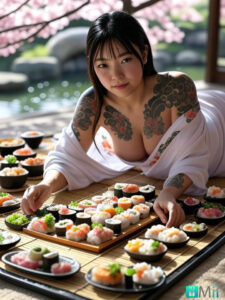Nyotaimori: The Art and Cultural Significance of Japanese Body Sushi
In the diverse landscape of global culinary traditions, few practices capture the imagination quite like Nyotaimori. This unique Japanese dining experience, often referred to as “body sushi” or “naked sushi,” represents a fascinating intersection of gastronomy, artistry, and cultural expression. This article explores the origins, cultural significance, modern interpretations, and ethical considerations surrounding this intriguing practice.
What is Nyotaimori?

Nyotaimori (女体盛り) translates literally to “female body arrangement” in Japanese. The practice involves presenting sushi and sashimi on the nude body of a model who has been specifically trained to lie still for extended periods. The companion practice featuring male models is called Nantaimori (男体盛り).
The model’s body serves as a living platter, carefully adorned with strategically placed leaves or other natural elements before the food is arranged. Traditional Nyotaimori emphasizes artistic presentation, with the human canvas becoming an integral part of the dining aesthetic.
Historical Origins and Cultural Context
While often assumed to be an ancient practice, historical documentation of Nyotaimori is surprisingly limited. Some scholars suggest it originated during the samurai period in Japan’s Edo era (1603-1868), potentially as an exclusive entertainment form for wealthy merchants and nobility. However, concrete historical evidence remains sparse.
The practice embodies several core principles of traditional Japanese aesthetics:
– Wabi-sabi: Finding beauty in imperfection and transience
– Ma: The meaningful spaces between elements
– Miyabi: Elegant simplicity and refinement
In traditional Japanese culture, the body was not always viewed with the same taboos as in Western societies, allowing for a different perspective on this form of presentation. The practice follows strict protocols and is conducted with great reverence for both the model and the culinary artistry.
Modern Interpretations and Global Spread
Today’s Nyotaimori experience has evolved considerably from its origins. Modern interpretations often incorporate:
– Professional models specially trained for the practice
– Sanitary measures including food-safe barriers between the body and food
– Artistic lighting and environmental design to enhance the aesthetic experience
– Inclusion in exclusive high-end dining experiences and special events
The practice has gained popularity in major global cities like New York, London, Las Vegas, and Sydney, where it’s typically offered as a premium dining experience. Contemporary Nyotaimori sometimes features models wearing minimal, skin-colored undergarments to address modern hygiene and cultural sensitivities while preserving the visual aesthetic.
The Culinary Artistry
The sushi selection in Nyotaimori demands exceptional quality and artful presentation. Common elements include:
– Nigiri: Hand-pressed sushi rice topped with fresh fish
– Sashimi: Thinly sliced raw fish arranged in patterns
– Maki: Various sushi rolls strategically placed
– Edible garnishes: Creating visual harmony across the human canvas
Master sushi chefs consider temperature control, placement, and visual composition when arranging each piece. The ephemeral nature of the art form—existing only until the food is consumed—connects with the Japanese concept of mono no aware, the appreciation of impermanence.
Etiquette and Respect
Participating in Nyotaimori requires adherence to specific protocols that honor both the model and the culinary tradition:
1. Guests should maintain respectful conversation and behavior
2. Food is removed using chopsticks, never touching the model directly
3. Photographs are typically prohibited unless explicitly permitted
4. Communication with the model is limited or avoided entirely
These guidelines ensure the dignity of all participants and preserve the ceremonial nature of the experience.
Contemporary Ethical Considerations
The practice of Nyotaimori has sparked significant ethical discussions in modern contexts. Critics raise concerns about objectification, consent, and cultural appropriation. Proponents argue that when practiced with proper consent, compensation, and cultural understanding, it represents a legitimate art form and cultural expression.
Key ethical considerations include:
– Ensuring models participate voluntarily with full understanding
– Providing appropriate compensation for the physically demanding work
– Creating safe, respectful environments free from harassment
– Understanding the cultural context rather than reducing it to novelty
Many contemporary Nyotaimori experiences address these concerns through professional standards, clear boundaries, and proper cultural education for participants.
The Future of Nyotaimori
As global conversations around body autonomy, cultural exchange, and culinary traditions evolve, so too does the practice of Nyotaimori. Modern interpretations increasingly emphasize:
– The artistic and performance aspects over mere novelty
– Education about the cultural context and significance
– Innovative approaches that respect both tradition and contemporary values
– Integration with other Japanese art forms for a more holistic cultural experience
Some restaurants now offer virtual or augmented reality experiences that simulate the visual aesthetic while addressing ethical concerns. Others focus on body painting or clothed interpretations that capture the artistic spirit while aligning with diverse cultural comfort levels.
Experiencing Nyotaimori Respectfully
For those interested in experiencing this unique cultural practice, approaching it with the right mindset is essential:
– Research establishments that prioritize ethical practices
– Understand the cultural significance beyond novelty
– Follow all etiquette guidelines without exception
– Approach the experience with appreciation for the artistry involved
The most authentic experiences emphasize the culinary excellence, artistic presentation, and cultural significance rather than sensationalism.
Nyotaimori represents a complex cultural practice that continues to evolve in the modern world. When approached with respect, cultural understanding, and ethical consideration, it offers a unique window into Japanese artistic traditions and culinary excellence. Like many cultural practices that challenge conventional boundaries, its future will likely continue to adapt while maintaining connections to its artistic roots.
As global diners become increasingly sophisticated and culturally aware, the practice of Nyotaimori has an opportunity to transcend controversy and be appreciated for what it truly represents: a bold intersection of human artistry, culinary excellence, and cultural expression that challenges us to reconsider our relationship with food, art, and the human form.


